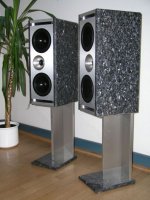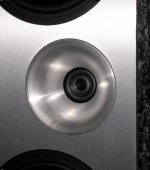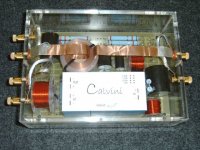Hi guys just wandering if someone can give me info on these 2 woofers(PL18WO-09-08 and XG18WH00-08), i am planning on building a 20-23L ported box tuned at around 40hz using one of these drivers and i need to mate it with the XT25TG-30-04(already got the tweeter). I am after sound quality as well but i would like to stay with a choice of these 2 drivers if possible.Im trying to achieve sound quality to dollar value as these drivers are not too expensive but seem to be of quite a good quality. Just not too sure whcich will work best with the xt25. Absolutely any info would be very appreciated.I would like to keep it the same brand too if possible. But will gladly take any advice given to me seriously.
Regards
Bowdown
Keep up the diy spirit
Regards
Bowdown
Keep up the diy spirit
Those wood pulp drivers will have a definite rise before you get up to the tweeters crossover point. I had that wooden drivers already. They look cool but i dont think they are all that practical in a 2 way. Thats an opinion by the way. I never did put them in a box and play them for 2 weeks so i could actually hear what they would sound like. I just Modeled them.
Disabled Account
Joined 2003
You're in luck
Good design all figured out (best for people without measuring equipment IMHO)
http://home1.stofanet.dk/troels.gravesen/index_b/PL18XT.htm
Good design all figured out (best for people without measuring equipment IMHO)
http://home1.stofanet.dk/troels.gravesen/index_b/PL18XT.htm
Hi guys sorry its me again i was looking at one of these 2 way systems and was wandering which one would be better?
http://www.partsexpress.com/projectshowcase/nebula/nebula.html
and the Korrekt from this one
http://www.audiocomponents.nl/speakers/vifa/xt/vifa-xt-line_eng.htm
I look at the one that tktran posted but worked out to be too expensive due to so many cross over parts. Please Please help.
Regards
Bowdown
http://www.partsexpress.com/projectshowcase/nebula/nebula.html
and the Korrekt from this one
http://www.audiocomponents.nl/speakers/vifa/xt/vifa-xt-line_eng.htm
I look at the one that tktran posted but worked out to be too expensive due to so many cross over parts. Please Please help.
Regards
Bowdown
bowdown said:Hi guys sorry its me again i was looking at one of these 2 way systems and was wandering which one would be better?
http://www.partsexpress.com/projectshowcase/nebula/nebula.html
I doubt if this kit does what it promises. I can't think that a serious designer would put the drivers non-flush mounted and the box edges that sharp. Especially the tweeter's plate edges create major peaks and dips due to diffraction, which is not shown in this kit's measurement plot at all... (to be fair, the first plot is a simulation from Speaker Workshop, which uses the actual measurements of the drivers for the simulation, so the dips and peaks of the tweeter should be visible)
I vote for the Troels Gravesen design, at least its certain that he knows what he is doing.
Besides the vertical axis of the SPL graph has a range of 180 dB !!!!!!!!!!!!!!!!!!
Hi,
the PL18 is a very nice driver, but to my opinion the 17WN225-8 is even better (and cheaper too), because it was build with midrange purposes in mind. It features a very leightweight moving system and a nearly perfect roll-off and step response. This helps keeping the crossover very simple. I build a box using two of those and the XT25. Because the XT is bit too low in SPL for this, I had a spherical horn made from massive aluminium. The very positive effects were, that the SPL of the XT went up to a 100dB@2kHz with an constant tilt towards the upper frequencies. This leads to smaller values in the crossover, as well as reduced distortion and higher dynamic range. The horn is loaded up to more than 15kHz with a nice roll off above. People said, they hardly ever heard the XT soo smooth but so dynamic alltogether. An additional effect is that the Tweeter is 38mm ´behind´ the woofers, which gave an excellent overall step-response!
The box has an SPL of 93db/2.83V/1m and is intended to be postioned close to the wall, for smaller rooms and for shorter hearing distances.
In rooms greater than app. 25m² You should add a good subwoofer. My preferred setup is the new KR-Audio A340 a SE-Triode amp featuring the marvellous KR-300BXLS Triode. It delivers app. 25 of the best Watts You can get Actively crossed over to an dipole Sub You can play levels well above pain with this amp and run this setup in large rooms.
Actively crossed over to an dipole Sub You can play levels well above pain with this amp and run this setup in large rooms.
jauu
Calvin
the PL18 is a very nice driver, but to my opinion the 17WN225-8 is even better (and cheaper too), because it was build with midrange purposes in mind. It features a very leightweight moving system and a nearly perfect roll-off and step response. This helps keeping the crossover very simple. I build a box using two of those and the XT25. Because the XT is bit too low in SPL for this, I had a spherical horn made from massive aluminium. The very positive effects were, that the SPL of the XT went up to a 100dB@2kHz with an constant tilt towards the upper frequencies. This leads to smaller values in the crossover, as well as reduced distortion and higher dynamic range. The horn is loaded up to more than 15kHz with a nice roll off above. People said, they hardly ever heard the XT soo smooth but so dynamic alltogether. An additional effect is that the Tweeter is 38mm ´behind´ the woofers, which gave an excellent overall step-response!
The box has an SPL of 93db/2.83V/1m and is intended to be postioned close to the wall, for smaller rooms and for shorter hearing distances.
In rooms greater than app. 25m² You should add a good subwoofer. My preferred setup is the new KR-Audio A340 a SE-Triode amp featuring the marvellous KR-300BXLS Triode. It delivers app. 25 of the best Watts You can get
jauu
Calvin
Attachments
Description
Hi,
the project started in 2004, when the German KR-Audio Distributor asked me for a box to perform with KR´s superb Triode amps at the High-End fair in Munic.
Additionally they looked for a box that could be sold as a package solution with their amps (the smallest delivering just 12W).
The big problem with the fair was that the listening cabins were a mere 18m² (3x6), so the usual candidates fell aside. We needed a compact but good performer in even very small rooms, positioned very close to the walls and the listeners and with high efficiency.
I chose a symmetrical style with two woofers to get good efficiency and to control dispersion. The Vifa can play in very small cabinet volumes (12.5L) tuned to 55Hz. Believe me...right in front of a wall and using the roomgain it plays even the lowest plugged string of a bass. Therefore You need a sub only for bigger rooms. You might use cabinets up to 25L and get down with the tuning frequency, but I prefer to have it very compact and supported with a dedicated sub. The result is a very dry and punchy sounding bass. Dynamics are very high. The crossover is a simple series coil and an impedance-correcting RC network. The Vifas have one of the smoothest rolloffs You can get. It might even play well up to 4kHz without any network if it wasn´t for directionality.
I use the Vifa XT25 as a partner. At first I didn´t have a horn in mind, but the first measurement showed me the prob!!! Too low in efficiency...just one little dB too less, but it was clearly audible. Too the step response wasn´t such I like it. So I designed a spherical horn which is to be glued into the front. This gave a rise in efficiency @2kHz from 92dB to nearly 100dB and a tilted response. This is countered by the crossover thats capacity values can be reduced.
The horn sets the tweeter 32mm back, which gave a very good integration with the woofers step responses. One drawback should be mentioned. The XT25 is a quite directional speaker. With horn its even more so, so this box is one where You should really sit right at the sweet spot. And this means absolutely equal distances to both speakers!
Crossover frequency is at 3kHz. Electrically the two filters differ, but acoustically they have the same slope. Acoustical phase is flat between 300Hz and 10kHz. Additional impedance correcting networks are installed. You won´t need them with sand amps and probabely not even with tubes, but generally prefer tube amps more constant impedances. The crossover is made from high quality components and is housed in a transparent acrylic cabinet. It´s stood right behind the backwall of the stands.
Distortion measurements showed low levels at any power.
The cabinet is constructed out of fibre board thats coated with aluminium layers. (You can buy them in many different metallic styles off the shelf and it spares You a lot of work for the finish). The sides are made of granit (Labrador blue pearl with a high blue colour content), but You may use any other stone. This fulfills several aims. First is to have the acoustical and optical benefits of a stone cabinet, without the hassel of manufacturing cutouts etc. The biggest surfaces are made from the superior stone, the smaller surfaces -which have to have cutouts, holes and so on- are made of easy to handle wooden material. The BR-channels are made from the same wooden material and raise the stability of the cabinet even more.
You may for example use longer plates of stone for the sides to use them as an integrated stand or do as I did with a dedicated stand . Doing the cabinets like this gives a nice bi-colour-design with nearly countless different colour and surface combinations and every box is a unique piece by appearance.
The sides are glued to the wooden corpse with a special silicon-like glue. So manufacturing of the box is quite easy, especially when You can get the stone plates in the right dimensions at every diy-market.
jauu
Calvin
Hi,
the project started in 2004, when the German KR-Audio Distributor asked me for a box to perform with KR´s superb Triode amps at the High-End fair in Munic.
Additionally they looked for a box that could be sold as a package solution with their amps (the smallest delivering just 12W).
The big problem with the fair was that the listening cabins were a mere 18m² (3x6), so the usual candidates fell aside. We needed a compact but good performer in even very small rooms, positioned very close to the walls and the listeners and with high efficiency.
I chose a symmetrical style with two woofers to get good efficiency and to control dispersion. The Vifa can play in very small cabinet volumes (12.5L) tuned to 55Hz. Believe me...right in front of a wall and using the roomgain it plays even the lowest plugged string of a bass. Therefore You need a sub only for bigger rooms. You might use cabinets up to 25L and get down with the tuning frequency, but I prefer to have it very compact and supported with a dedicated sub. The result is a very dry and punchy sounding bass. Dynamics are very high. The crossover is a simple series coil and an impedance-correcting RC network. The Vifas have one of the smoothest rolloffs You can get. It might even play well up to 4kHz without any network if it wasn´t for directionality.
I use the Vifa XT25 as a partner. At first I didn´t have a horn in mind, but the first measurement showed me the prob!!! Too low in efficiency...just one little dB too less, but it was clearly audible. Too the step response wasn´t such I like it. So I designed a spherical horn which is to be glued into the front. This gave a rise in efficiency @2kHz from 92dB to nearly 100dB and a tilted response. This is countered by the crossover thats capacity values can be reduced.
The horn sets the tweeter 32mm back, which gave a very good integration with the woofers step responses. One drawback should be mentioned. The XT25 is a quite directional speaker. With horn its even more so, so this box is one where You should really sit right at the sweet spot. And this means absolutely equal distances to both speakers!
Crossover frequency is at 3kHz. Electrically the two filters differ, but acoustically they have the same slope. Acoustical phase is flat between 300Hz and 10kHz. Additional impedance correcting networks are installed. You won´t need them with sand amps and probabely not even with tubes, but generally prefer tube amps more constant impedances. The crossover is made from high quality components and is housed in a transparent acrylic cabinet. It´s stood right behind the backwall of the stands.
Distortion measurements showed low levels at any power.
The cabinet is constructed out of fibre board thats coated with aluminium layers. (You can buy them in many different metallic styles off the shelf and it spares You a lot of work for the finish). The sides are made of granit (Labrador blue pearl with a high blue colour content), but You may use any other stone. This fulfills several aims. First is to have the acoustical and optical benefits of a stone cabinet, without the hassel of manufacturing cutouts etc. The biggest surfaces are made from the superior stone, the smaller surfaces -which have to have cutouts, holes and so on- are made of easy to handle wooden material. The BR-channels are made from the same wooden material and raise the stability of the cabinet even more.
You may for example use longer plates of stone for the sides to use them as an integrated stand or do as I did with a dedicated stand . Doing the cabinets like this gives a nice bi-colour-design with nearly countless different colour and surface combinations and every box is a unique piece by appearance.
The sides are glued to the wooden corpse with a special silicon-like glue. So manufacturing of the box is quite easy, especially when You can get the stone plates in the right dimensions at every diy-market.
jauu
Calvin
Attachments
- Status
- This old topic is closed. If you want to reopen this topic, contact a moderator using the "Report Post" button.
- Home
- Loudspeakers
- Multi-Way
- Vifa Pl18wo Or Xg18wh



